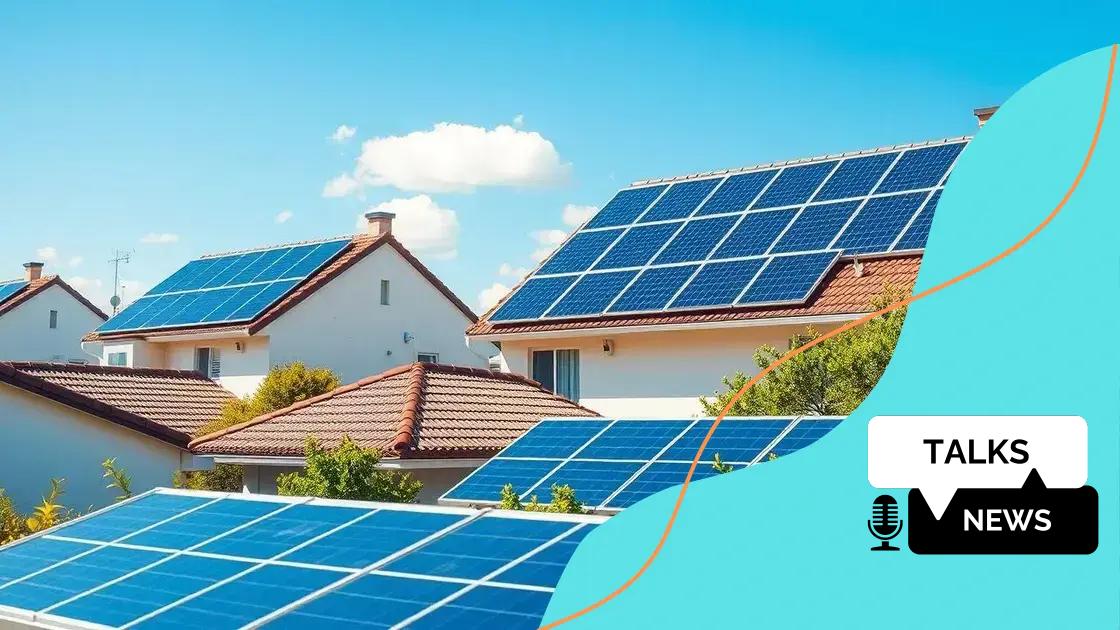Renewable energy subsidies for homeowners and businesses

Renewable energy subsidies for homeowners and businesses provide financial incentives, such as tax credits and grants, to reduce energy costs while promoting sustainable practices.
Renewable energy subsidies for homeowners and businesses offer a fantastic opportunity to cut costs and support sustainable practices. Have you considered how these incentives could transform your energy expenses? Let’s explore how you can take advantage.
Understanding renewable energy subsidies
Understanding renewable energy subsidies is crucial for homeowners and businesses wanting to reduce energy costs and support green initiatives. These financial incentives make it easier to invest in sustainable solutions.
What Are Renewable Energy Subsidies?
Renewable energy subsidies are financial aids provided by the government or other organizations to encourage the adoption of clean energy technologies. These can include grants, rebates, and tax credits.
Benefits of Renewable Energy Subsidies
By utilizing these subsidies, you can achieve significant savings. Here are vital benefits:
- Lower upfront costs for solar panel installations.
- Tax credits that reduce your overall tax liability.
- Increased home value due to energy-efficient upgrades.
- Contributing to environmental sustainability.
When you take advantage of these opportunities, you not only save money but also support a cleaner environment. Understanding how these subsidies work is essential for maximizing your benefits.
For businesses, these subsidies can significantly lower operating costs. Investing in renewable energy not only provides financial relief but also enhances your company’s public image. Consumers appreciate brands that prioritize sustainability.
How to Qualify for Subsidies
To qualify for renewable energy subsidies, it’s important to meet specific requirements set by your local or federal government. These requirements often include:
- Using approved renewable energy technologies.
- Meeting installation standards set by regulators.
- Providing necessary documentation to apply.
By ensuring you meet these criteria, you can gain access to numerous financial aids designed to encourage renewable energy use. With the right information, applying for these subsidies can be a straightforward process.
Many homeowners and businesses have successfully benefited from these incentives. Tapping into renewable energy subsidies not only helps you save money but also plays a vital role in fostering a sustainable future. Don’t miss out on these incredible opportunities!
Types of subsidies available for homeowners
There are several types of subsidies available for homeowners looking to invest in renewable energy. Understanding these options can help you maximize your savings while contributing to a greener planet.
Federal Tax Credits
One of the most popular forms of subsidy is the federal tax credit. This credit allows homeowners to deduct a percentage of the cost of renewable energy installations, like solar panels, from their federal taxes. It’s a great way to save money on your tax bill while investing in clean energy.
State and Local Incentives
Many states offer additional incentives, including rebates or grants, to encourage the adoption of renewable energy solutions. These can vary widely by location, but they often complement federal tax credits and can lead to substantial savings.
- Rebates for solar water heaters.
- Grants for energy-efficient home improvements.
- Low-interest loans for solar panel installations.
Homeowners should research their state’s program to see what incentives are available. Such programs are designed to make clean energy more accessible and affordable.
Another important type of subsidy is the performance-based incentive. This is where homeowners receive payments based on the amount of energy their renewable systems generate. It’s a fantastic way to earn money back while using sustainable energy sources.
Utility Company Programs
Many utility companies offer their own incentives to encourage customers to switch to renewable energy. These programs may include discounts on installation costs or special pricing for energy generated from renewable sources. It’s worth checking with your local utility provider to see what options you have.
By taking advantage of these various subsidies, homeowners can significantly reduce the costs associated with switching to renewable energy, making it a more attractive option. With the right financial aids, the transition to sustainable energy is not only feasible but beneficial.
Financial incentives for businesses

When it comes to financial incentives for businesses, understanding the available options is key to making smart investments in renewable energy. Many businesses can benefit from programs designed to promote sustainability and reduce energy costs.
Tax Credits for Businesses
One significant incentive is the tax credit specifically for businesses that invest in renewable energy technology. This includes solar energy systems, wind turbines, and energy-efficient equipment. By taking advantage of these credits, companies can reduce their taxable income and lower their overall tax burden.
Grants and Rebates
Aside from tax credits, many governments offer grants and rebates aimed at businesses looking to implement green technologies. These direct monetary aids can cover a substantial portion of the installation costs. Here are some common options:
- Grants for energy-efficient upgrades.
- Rebates for installing solar panels.
- Financial support for energy audits.
These options make it easier for businesses to transition to renewable energy, contributing to lower operational costs. Implementing sustainable technology not only positively affects your budget but also builds a reputation as an eco-friendly company.
Low-Interest Loans
Low-interest loans are another way businesses can finance their renewable energy projects. These loans often have favorable terms, making it easier to invest in long-term energy-saving solutions. By reducing financing costs, businesses can enhance their cash flow and invest in growth.
Moreover, as businesses embrace sustainable practices, they often see increased interest from customers who value environmental responsibility. Utilizing financial incentives encourages more companies to explore renewable energy options, fostering a collective effort towards sustainability.
How to apply for renewable energy subsidies
Applying for renewable energy subsidies can seem complicated, but breaking it down into steps makes it manageable. Understanding the application process is crucial for homeowners and businesses eager to save money while going green.
Research Available Subsidies
The first step is to research the various subsidies available in your area. This can typically be found on state government websites or local utility company pages. Look for incentives that fit your situation, whether you’re a homeowner or a business.
Check Eligibility Requirements
Every subsidy has specific eligibility criteria. Carefully read these requirements to ensure that you qualify. This may include:
- Using approved technologies.
- Meeting installation deadlines.
- Providing documentation of costs.
Understanding these points early can prevent delays in the application process and enhance your chances of receiving funding.
Gather Necessary Documentation
Once you’ve identified the relevant subsidies, the next step is to gather all necessary documentation. This typically includes:
- Proof of ownership of the property.
- Receipts for any costs incurred.
- Technical specifications of the renewable energy system installed.
Having these documents ready will streamline your application process significantly, making it easier to submit everything properly.
Submit Your Application
After gathering the necessary information and documents, follow the specific instructions on how to submit the application. Some may require online submission, while others may need paper forms. Make sure to double-check all fields for accuracy before submitting.
After submitting, keep records of your application. This includes confirmation emails or tracking numbers. Patience is key, as processing times vary.
By understanding how to apply for renewable energy subsidies, you empower yourself to take advantage of financial incentives. Keeping organized and being thorough in your application will increase your chances of success.
Tips for maximizing your benefits
To ensure you get the most out of renewable energy subsidies, there are several tips that can help you maximize your benefits. Being proactive and informed is essential in this process.
Stay Informed About Changes
Subsidy programs can change frequently, so it’s important to stay updated on the latest information. Regularly check the websites of local and federal agencies that administer these programs to ensure you’re aware of any new incentives or changes to existing ones.
Consider Multiple Options
Many homeowners and businesses qualify for more than one type of subsidy or incentive. Here are a few options to consider:
- Federal tax credits.
- State and local grants.
- Utility company rebates.
- Performance-based incentives.
Applying for all eligible programs can significantly increase your overall benefits, making the transition to renewable energy more affordable.
Properly Document Everything
Keeping accurate records is vital when applying for subsidies. Make sure you document:
- All expenses related to renewable energy installations.
- Installation dates and provider information.
- All correspondence regarding your applications.
This documentation will help establish your eligibility and streamline the application process.
Consult Experts
Working with professionals who understand the complexities of renewable energy incentives can be beneficial. They can guide you through the application process and help you leverage all available opportunities.
Maximizing your benefits from renewable energy subsidies requires effort, but the long-term savings and rewards are worth it. By following these tips, you can make informed decisions that will ultimately lead to a more sustainable and cost-effective energy solution.
In conclusion, understanding and utilizing renewable energy subsidies can lead to significant savings for both homeowners and businesses. By staying informed about available options, being diligent in the application process, and seeking expert advice, you can maximize the benefits of these financial incentives. Embracing renewable energy not only helps reduce costs but also contributes to a more sustainable future for everyone. Take the first step today and explore how you can benefit from these valuable programs!
\n
\n
FAQ – Frequently Asked Questions About Renewable Energy Subsidies
What types of renewable energy subsidies are available?
There are various subsidies, including federal tax credits, state grants, utility company rebates, and performance-based incentives.
How can I apply for renewable energy subsidies?
To apply, research available subsidies, check eligibility requirements, gather necessary documentation, and submit your application according to the guidelines provided.
How do financial incentives benefit businesses?
Financial incentives help businesses reduce installation costs for renewable energy systems, improve cash flow, and enhance their reputation as environmentally responsible.
What should I do to maximize my benefits from these subsidies?
Stay informed about changes in subsidy programs, consider multiple options, properly document all applications, and consult experts if needed.





